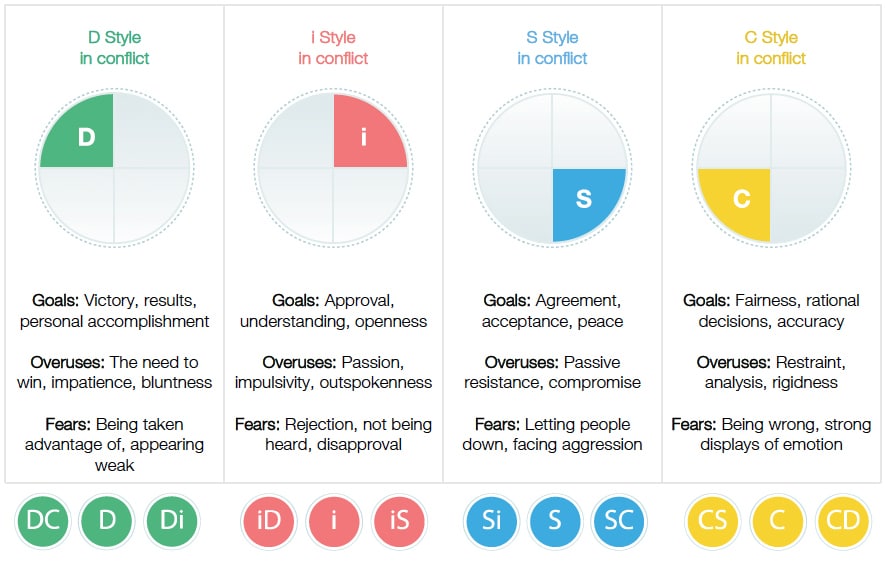Managing Conflict on Teams

Key Takeaways
- Conflict on teams is natural. The key is to turn conflict into productive debate rather than fighting.
- Conflicts arise from lack of clarity around roles and processes, personality clashes, and differing values.
- Leaders can manage conflict on teams by looking for early signs, fostering trust and open communication, and focusing on shared objectives.
Managers can handle conflict better by building a foundation of trust and open communication on the team. A strong team will often be able to resolve conflicts among team members without getting the manager involved.
United Nations training manual: Skills Development for Conflict Transformation
3 common causes of conflict on teams
Understanding what type of conflict you're seeing helps determine how you manage it.
1. Task or process conflict
Task conflict can occur because there’s a lack of clarity around roles and responsibilities on the team. Unclear expectations for performance levels or policies can also lead to task conflict. Example: You have four people to handle job tickets, but no one is grabbing them from the queue and they're piling up. This is a manager’s job to fix with clearer communication around expectations and/or better procedures.
An example of a process conflict could be a new nurse inserting an IV using a different technique than the hospital uses. Maybe the new technique is better, or maybe not. The manager can help focus the conflict on which procedure has the best outcome for the patient, thereby meeting team goals.
Some task or process conflict can be productive for teams. For example, your team is planning a big event. You want someone with bold and creative ideas and you also want someone who is thinking about practicalities like the budget. This tension between roles can be a creative force that leads to better judgments and decisions.
2. Relationship conflict
What begins as a task-related conflict can escalate into a personal one. If you don't address the original disagreement, it can lead to resentment, gossip, or distrust. Of course, relationship conflicts can also occur independently of other conflicts.
Teams often contain an assortment of people who wouldn’t normally have an affinity for each other. You can expect differences in personality, style, matters of taste, and more. Building trust on teams is important so these differences don't become divisive. You want the team to respect and value differences.
This is one area in which personality assessments can be helpful. With them, teams gain a shared and nonjudgmental language for identifying and discussing differences. Understanding how differences make a group stronger goes a long way toward creating a collaborative environment.
3. Values conflict
Conflict over values can be the trickiest to navigate. This type of conflict can arise from fundamental differences in politics, religion, ethics, norms, and other deeply held beliefs. Even if the team has agreed not to discuss politics and religion, value disputes can arise when making work decisions.
Disputes centered on values can bring out defensiveness, distrust, and feelings of alienation. People can become deeply rooted in their positions and feel threatened by a compromise.
Managers may want to step in and settle these conflicts according to their own values. If these values align with the company’s mission or policies, this can be the right approach.
However, if they are not, then the manager should facilitate respectful dialogue, aiming only for understanding, not resolution. The manager can appeal to values that everyone on the team shares. They should focus on these values instead of those that caused the dispute.
10 conflict resolution strategies
Here are some steps successful teams and team leaders take to manage conflict.
1. Observe and respond
Don’t wait for team members to bring their conflicts to you. You can be proactive if you are observant and address possible conflicts before they become real concerns.
Look for signs of conflict. Is someone sitting in a meeting with arms crossed and jaw clenched? Do two team members seem to be having a separate chat during a Zoom meeting? Has someone who usually contributed to discussions suddenly gone quiet? Did someone make a dismissive or rude comment?
Immediately address the observed behavior with curiosity. You’ll be modeling productive behavior to your team and you may surface issues your team needs to address.
2. Know your own style of conflict
Self-knowledge is always a good place to begin when dealing with management issues. Your response to conflict situations is in your own control, and how you handle conflict will affect your team.
What are your most common positive and negative responses to conflict? Are you willing to have objective debates? Do you look out for people’s feelings? Do you start talking over others? Do you become overly critical in response to conflict? Even if you don’t know, your team probably does, and they want more of the positive and less of the negative from you.
3. Clarify task and role expectations
Teams can avoid many conflicts with clarity around roles. Everyone should understand their role and what they have committed to. The team should discuss how they will hold each other accountable.
4. Focus on shared goals
Every team member should know the team goals and how you'll work toward them. Keeping focused on the final goal means people are less likely to get caught up in minor arguments.
5. Discuss different styles of debating
Some people equate raised voices with passion. Others sense hostility when volumes rise. Can the group agree on a set of behaviors they want to see everyone use during debate?
Review your DiSC® styles, Five Behaviors® Team Development conflict map, or other assessments. Discuss how each personality type deals with conflict and how you see that played out on your team. What are your team’s rules of engagement?

6. Foster an environment of psychological safety
Individuals are more prone to misbehavior when experiencing fear or anxiety. Embrace conflict as a crucial and unavoidable aspect of teamwork. Encourage open discussions among team members and managers about the nature of constructive competition and healthy conflict.
Team members need to discuss how they will challenge each other’s assumptions, behaviors, and ideas. Doing so in a way that feels psychologically safe is key to high-producing teams.
7. Schedule regular team checkpoints
Checkpoints invite team members to bring up concerns at regular intervals during a project. Not everyone is comfortable initiating a conversation about their concerns. Checkpoints create an opening to voice these worries. Keep these checkpoints separate from meetings focused on reporting on individual progress.
8. Discuss conflict during onboarding
When bringing on new team members, set expectations for how the team welcomes and navigates productive conflict. Personality assessments can identify a new hire's likely tendencies during conflict. Managers can onboard new team members knowing where unhealthy conflicts might arise from differing personal priorities or work styles.
Annie McKee in Why We Fight at Work
9. Act as mediator
Managers who don’t want individuals repeatedly coming to them to solve conflicts can teach conflict resolution skills. When team members participate in making a decision, they are more likely to follow through on it. They'll learn skills to engage in future conflicts without your intervention.
Ask questions that will help you and others understand the disagreement. Bring their positions, interests, and priorities into clearer focus. You might want to restate their comments, rephrasing comments in a more positive way. Express empathy for the difficulties experienced, but don't imply support for one person’s position over another’s.
When you use mediation skills to model healthy conflict, you're teaching your team how to resolve conflicts on their own.
10. Remember that conflict can be positive
Not all conflict has a negative effect on team performance. Debate that is focused on concepts and ideas and avoids mean-spirited, personal attacks can be very productive. Teams might not even recognize it as conflict.
What does productive conflict look like? The Five Behaviors Team Development profile offers these examples:
- Team members voice their opinions even at the risk of causing disagreement.
- Team members solicit one another’s opinions during meetings.
- When conflict occurs, the team confronts and deals with the issue before moving to another subject.
- During team meetings, the most important—and difficult—issues are discussed.
What does this mean for the manager?
You don’t need to automatically step in when things get emotional. Step in if things get personal or abusive. Otherwise, the passion your team is showing can lead to great ideas and problem-solving.
Seek out opinions. Don’t just have an open-door policy. Ask for feedback. Provide multiple ways for people to offer it. Show that you will take feedback and act on it.
Even when you have the authority to make a decision, consider giving your team the opportunity to weigh in. The collaborative process might lead to a better decision. It will certainly lead to better buy-in from your team.
Celebrate the fruitful results of conflict. Share your appreciation when someone brings a difficult issue to the surface. Share what you learned during a debate. Review the behaviors that led to successful results.
Engaging in productive conflict can give your team an advantage by increasing learning, creativity, and innovation; encouraging real collaboration; and achieving long-lasting results. It’s worth celebrating.
Posted 01/24/2025







